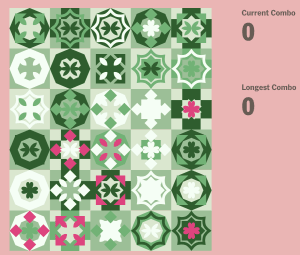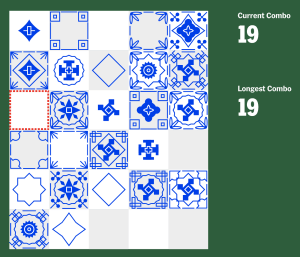I'm obsessed with The New York Times' Tiles game
This delightfully slow game will be your new addiction


I'm not typically a big mobile game person. Part of that is because I have a military-grade iPhone case, designed to protect my screen from a cat bent on proving the universe's trend toward disorder, but which doesn't register rapid responses for time-sensitive games. I'm also easily distracted, swiping out of apps every few minutes to check push notifications and emails. Plus I generally seek to satisfy my competitive streak in more unhealthy ways, like caring far more than any self-respecting person should about the outcome of Seattle Mariners games.
All that being said, in the past few days I've become hopelessly addicted to Tiles.

(Screenshot of Tiles | The New York Times)
The Week
Escape your echo chamber. Get the facts behind the news, plus analysis from multiple perspectives.

Sign up for The Week's Free Newsletters
From our morning news briefing to a weekly Good News Newsletter, get the best of The Week delivered directly to your inbox.
From our morning news briefing to a weekly Good News Newsletter, get the best of The Week delivered directly to your inbox.
Unless you happen to frequent The New York Times' crossword puzzle page, you might have missed the rollout of Tiles earlier this week. Still, the launch is noteworthy in part because it is the Times' first original game that doesn't involve words. (Although Tiles doesn't have a stand-alone app, it can easily be played in a browser window on a computer or phone, and it's free even if you aren't a subscriber.)
On the surface, Tiles is a simple matching game in which you try to get the shortest "combo" possible while still achieving a "perfect game," which requires never breaking a matching streak. The Times' television critic and Tiles proselytizer Margaret Lyons reports that the lowest achievable combo is theoretically 15, although that would require every tile to be an exact match — unlikely, since the pattern shuffles are randomized.
At risk of saying too much, though, let me add that Tiles is best enjoyed by embracing its learning curve. In my excitement to play after seeing rave reviews on Twitter, I completely (and accidentally) blew past the tab that explained the rules. After some unstrategic clicking around the five-by-six board, I noticed I'd start to rack up a "current combo," while other times I'd be informed I'd done something wrong by a stern, sans-serif "no match" and my combo being reset to zero. After further exploration, I began to see the patterns, piecing together — albeit rather clumsily — what the game wanted me to do with the mess it had provided.
For The New York Times, this is the entire point. In its press release, the Times specifically noted that "one additional strategy around launching Tiles is to reach users who may not be native English-language speakers." But the game's accessibility doesn't mean it's boring; you get a flush of satisfaction (and dopamine) each time you start to piece the puzzle together. After several dozen rounds, I've gotten so fast now that when I crash headlong into an optical illusion or hidden pattern, messing up my score, I involuntarily throw my hands up in what must only be, to my colleagues, a humorous display of full-body frustration.
A free daily email with the biggest news stories of the day – and the best features from TheWeek.com

(Screenshot of Tiles | The New York Times)
There is no reason to rush Tiles, though. The single best aspect of the game is that there is no clock, and nothing external ever pressures you into making hasty, incorrect pairings. While many other matching games induce a sense of panic, or encourage competitiveness through global rankings, I find the unhurried pace of Tiles to be its greatest asset. It fits neatly into the trend of "slow games" — like the succulent-growing Viridi or my beloved cat-rearing Neko Atsume — that can be enjoyed in fits and starts throughout a busy workday. Tiles even offers a "zen mode" to crossword subscribers, in which you can play one infinite, hypnotizing round. Tellingly, Adweek writes that Tiles was the result of the Times' Games Expansions Team noticing "that users were writing in late at night asking the company for a game that would help them zone out."
The more you become obsessed with Tiles, though, the more intense its chess-like qualities become. You start to find yourself plotting several moves ahead in order to get a lower score. The game, in that way, is especially conducive to sparking creativity, the same way a shower might, supplying a winning combination of relaxation, distraction, and dopamine. I've found that when I pause during my day to play Tiles — perhaps after getting stuck on work, or while waiting for a reply to a Slack message — a few rounds get the juices flowing again. I've taken to keeping a game perpetually open in a tab to revisit during my downtime, rather than using stray moments to scroll through Twitter or make another vending machine run.
Tiles keeps you hooked by being just hard enough to never feel truly easy. Certain patterns can "hide" beneath other elements, and optical illusions in modes like "Austin" and "New Haven" (a different tileset is available each day for free, or you can toggle between them if have a subscription) can trip you up if you get going too fast. Only Hong Kong (the blue and white pattern above) is without the distraction of different colors, although its dizzying lines make it a beast when you get on too quick of a roll. I expect that, as users flock to the game, Tiles will add additional patterns for enthusiasts to get stumped by.
Really, though, there is no need to over-complicate things. Tiles proves that you don't need a leaderboard, countdown clock, or levels to make a great puzzle game. Sometimes all it takes is a premise so basic that you can forgo a rule book — at least so long as you have patience, time to kill, and a desire, even in this smallest of ways, to find some harmony in chaos.
Jeva Lange was the executive editor at TheWeek.com. She formerly served as The Week's deputy editor and culture critic. She is also a contributor to Screen Slate, and her writing has appeared in The New York Daily News, The Awl, Vice, and Gothamist, among other publications. Jeva lives in New York City. Follow her on Twitter.


